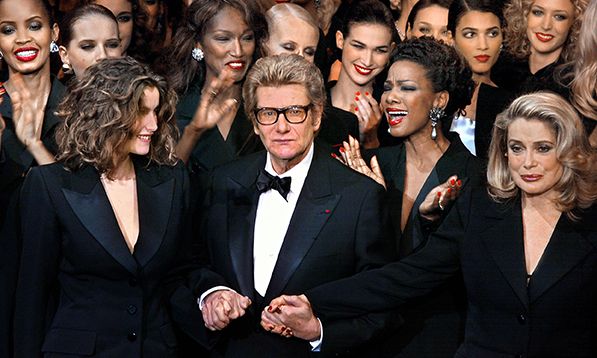Designer Yves Saint-Laurent with the French model Laetitia Casta (left) and the French actress Catherine Deneuve (R) at his last ever haute-couture show in 2002 © Jean-Pierre Muller/EPA
“Yves Saint Laurent’s years of great creativity did not last long. Over a 40-year career, ten years were a great success and 30, agony. But for that decade he was the undisputed master of the world stage.” This is how Giorgina Siviero, the style entrepreneur at the forefront of the Turin fashion world for the last half century, assesses the famous French designer.
Yves Saint Laurent (1936-2008), a pupil of Christian Dior, presented his first collection under his own name on 29 January 1962, at 30 Bis Rue Spontini in Paris. That was 60 years ago and for the anniversary, five major Paris museums have joined forces with the Musée Yves Saint Laurent Paris and the Fondation Pierre Bergé-YSL to present the clothes in dialogue with the works and artists who inspired them. For example, at the Centre Pompidou you can see Saint Laurent’s Romanian blouse inspired by a Henri Matisse painting—the painter par excellence for Saint Laurent—while the Musée du Louvre is showing jackets studded with gold and crystals from the 1990 Versailles collection under the golden ceiling of the Galerie d'Apollon, decorated by Charles Le Brun for Louis XIV.
The Art Newspaper: What did Yves Saint Laurent represent in the fashion world of the early 1960s?
Giorgina Siviero: He was the greatest couturier of his time and despite not having done anything extraordinary apart from design wonderful clothes, he has become a legend. From 1962 to 1972, his clothes expressed the taste of the day better than anyone else. He did not have the ability of Chanel to create a timeless style; he did not possess the mastery of Madeleine Vionnet nor the creative humour of Schiaparelli nor the technical ability of Balenciaga; he was not as modern as Courrèges; he did not have the ability to combine creativity and managerial rigour like Armani. Nevertheless, he was partly the sum of them all, with that extra aura of the “doomed genius”, which led him astray too soon but helped in the construction of his myth.
Intelligent and sensitive to epochal changes, Saint Laurent understood that he had to adapt to society and not vice versa. It is not true that a stylist influences society; with a careful look at what was happening around him, he managed to ride the wave of the moment. He was the first to be inspired by street fashion and show it on the catwalk; the first to propose gender equality in fashion.
Why was his creative contribution so important?
He gave birth to an elegant and androgynous type of woman. Right from his first fashion show in ‘62, he introduced almost all his characteristic garments that live on today: the tuxedo, the trouser suit, the pea coat, the desert jacket, the leather jacket and the suit. Chanel had already invented trousers for women, but he made them a cornerstone of his collections. He empowered women. While Chanel exploited their weakness, Saint Laurent believed in their strength. In ‘66 he opened the Rive Gauche boutiques with ready-made clothes, a development that has marginalised haute couture but offered customers cheaper alternatives.
Yves Saint Laurent's “Homage to Vincent van Gogh” jacket, 1988 © Yves Saint Laurent © Nicolas Mathéus
So he managed to grasp the spirit of the moment while drawing on what had already been done?
Yes, he was very good at referring to the past, drawing inspiration from art, history and what had been said before. His passion for art led him to pay homage to 20th-century painting, from Picasso to Warhol, from Matisse to Braque, from Mondrian to Tom Wesselmann and especially Van Gogh, when the combination of art and fashion was not yet a cliché. But even this had already been thought of by Schiaparelli in the 40s. Not even the critics’ denunciation of his infamous 1971 collection, which was inspired by wartime Nazi collaborationists and scandalised Paris, stopped his dazzling rise.
Is there a successor to Yves Saint Laurent today?
No. Today’s fashion is more communication than anything else. It is decided at the table by the large conglomerates that allocate stratospheric budgets, study the weaknesses of the masses, choose a character of great ability to whom they affix a brand whose founder is long deceased, and ask him or her to create a collection. But there is no longer a creator who comes out with their own name, who can make it without having millions of euros invested in them. There certainly is talent around, but it gets mediated, swallowed up by these groups, so there is no more room for the genius who goes their own way and does what they want by addressing their own audience.
• Yves Saint Laurent aux Musées, Centre Pompidou, Musée du Louvre, Musée d’Orsay, Musée d'art Moderne de la Ville de Paris, until 15 May; Musée Picasso, until 15 April
• Translated from Il Giornale dell'Arte

